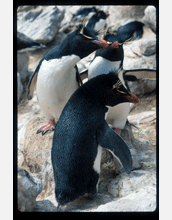Multimedia Gallery
Southern Rockhopper Penguin
A Southern Rockhopper penguin.
Unlike many other penguin species, who travel by sliding on their bellies or by awkwardly using their flipper-like wings to climb, rockhoppers will try to jump over boulders and across cracks--hence the name. They are a smaller-sized penguin, ranging in height from 18-23 inches and typically weighing 4.4 to 7.5 pounds.
This image was taken by Dee Boersma from the University of Washington, who has been studying a different species of penguin--the Magellanic penguin--in the South Atlantic over the past 23 years (see story below). [See related image Here.]
More about this Image
This image was taken by Dee Boersma, a professor in the department of biology at the University of Washington. Boersma's academic research is in the area of conservation biology, with focus on seabirds as indicators of environmental change. Over the past 23 years, she has carried out research on Magellanic penguins in the South Atlantic, assessing their biological characteristics and the effects of human perturbations and policy changes on their survival.
Boersma's research is primarily with the Magellanic penguin project, initiated in 1982 to protect the largest Magellanic penguin colony in the world, as well as study the diversity of wildlife at Punta Tombo, Argentina. A small group of researchers, under Boersma's direction, follow individual penguins, monitor the colony and develop the data needed to plan effective conservation efforts, as well as try and understand the importance of penguins as indicators of global climate change and the health of the environment.
For the last two decades, Boersma and her volunteers have identified penguins at Punta Tombo with a nametag--actually a flipper band, a small metal band with a number on it. The bands allow the researchers to easily identify which penguin is which when they record data along the beaches. Over 50,000 birds have been banded since 1983.
During breeding season (from September to March), the researchers visit each nest and determine how each couple is doing with raising their chicks. The birds determined to be good Dads will get a satellite tag, which enables researchers to see where the male travels when he searches for food. Studying penguins at sea helps Boersma and her team learn where they go and why some birds are more successful at rearing chicks than others.
Long term penguin studies, such as this one, are important because some of the changes scientists are seeing in the penguin populations are subtle, and would go undetected in a shorter study. Penguin research is important in helping us understand what effects humans are having on the environment, as well as training the next generation of conservation biologists.
Boersma has received support from the National Science Foundation in the past, most recently to attend the sixth International Penguin Conference, where scientists from around the world present their work, make contacts with others in their specific fields of interest, and forge international collaborative research efforts. To learn more about Boersma's research or to read her seasonal Newsletters, visit her website Here. (Date of Image: unknown)
Credit: Dee Boersma, University of Washington
Images and other media in the National Science Foundation Multimedia Gallery are available for use in print and electronic material by NSF employees, members of the media, university staff, teachers and the general public. All media in the gallery are intended for personal, educational and nonprofit/non-commercial use only.
Images credited to the National Science Foundation, a federal agency, are in the public domain. The images were created by employees of the United States Government as part of their official duties or prepared by contractors as "works for hire" for NSF. You may freely use NSF-credited images and, at your discretion, credit NSF with a "Courtesy: National Science Foundation" notation.
Additional information about general usage can be found in Conditions.
Also Available:
Download the high-resolution JPG version of the image. (996 KB)
Use your mouse to right-click (Mac users may need to Ctrl-click) the link above and choose the option that will save the file or target to your computer.

